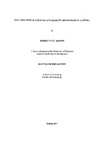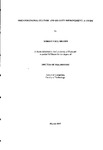Organisational culture and quality improvement : a study
| dc.contributor.author | Brown, Robert Paul | |
| dc.contributor.other | School of Engineering, Computing and Mathematics | en_US |
| dc.date.accessioned | 2011-10-03T11:47:48Z | |
| dc.date.available | 2011-10-03T11:47:48Z | |
| dc.date.issued | 1997 | |
| dc.identifier | Not available | en_US |
| dc.identifier.uri | http://hdl.handle.net/10026.1/819 | |
| dc.description | Merged with duplicate record 10026.1/2682 on 06.20.2017 by CS (TIS) | |
| dc.description.abstract |
The initial direction of this research was in the application of Quality tools and techniques, within the framework of the EFQM Model for Business Excellence. Three quality improvement projects managed by the author (Cost of Quality, BPR and Benchmarking) sought to identify the key elements of a process improvement methodology. However, the completion of the three case studies led the author to review the whole approach of the research. The review led to the need to develop an understanding of the culture and the environment of an organisation as a precursor to implementing quality improvement. The ability of an organisation to manage the process of continuous improvement or TQM implementation was fundamentally dependent on the culture of an organisation. Organisational culture is the bedrock upon which organisational change is based and an understanding of the culture could help the practitioner focus on key change issues at the outset. The main work in the research then set about attempting to develop and test a model of organisational culture and climate which would help practitioners develop a fuller understanding of organisational culture and internal environment before interventions were carried out. A process for developing an understanding of organisational culture and climate was derived, using information obtained from the culture, quality and climate literature and the review of the case studies. This process included the use of various tools and techniques such as multi-item questionnaire and focus groups. The process used Focus Groups to identify key issues within Lloyds TSB and to help develop a multi-item questionnaire, termed PCOC. The PCOC questionnaire was then tested in four different Areas of Lloyds TSB and the results were analysed and compared to identify similarities and differences across Business Areas. The implications for the implementation of quality improvement were identified and recommendations for managing change were made. | en_US |
| dc.language.iso | en | en_US |
| dc.publisher | University of Plymouth | en_US |
| dc.title | Organisational culture and quality improvement : a study | en_US |
| dc.type | Thesis | |
| dc.identifier.doi | http://dx.doi.org/10.24382/4155 | |
| dc.identifier.doi | http://dx.doi.org/10.24382/4155 |
Files in this item
This item appears in the following Collection(s)
-
01 Research Theses Main Collection
Research Theses Main



